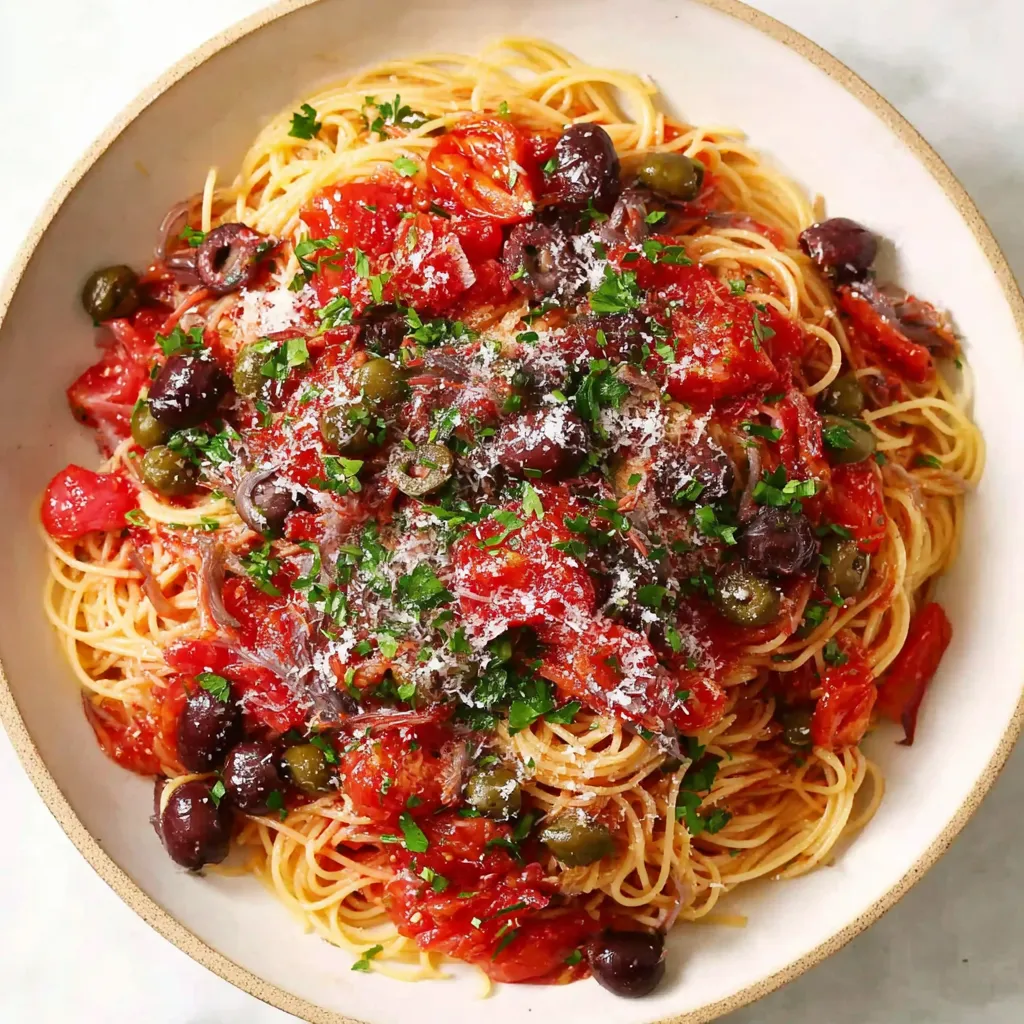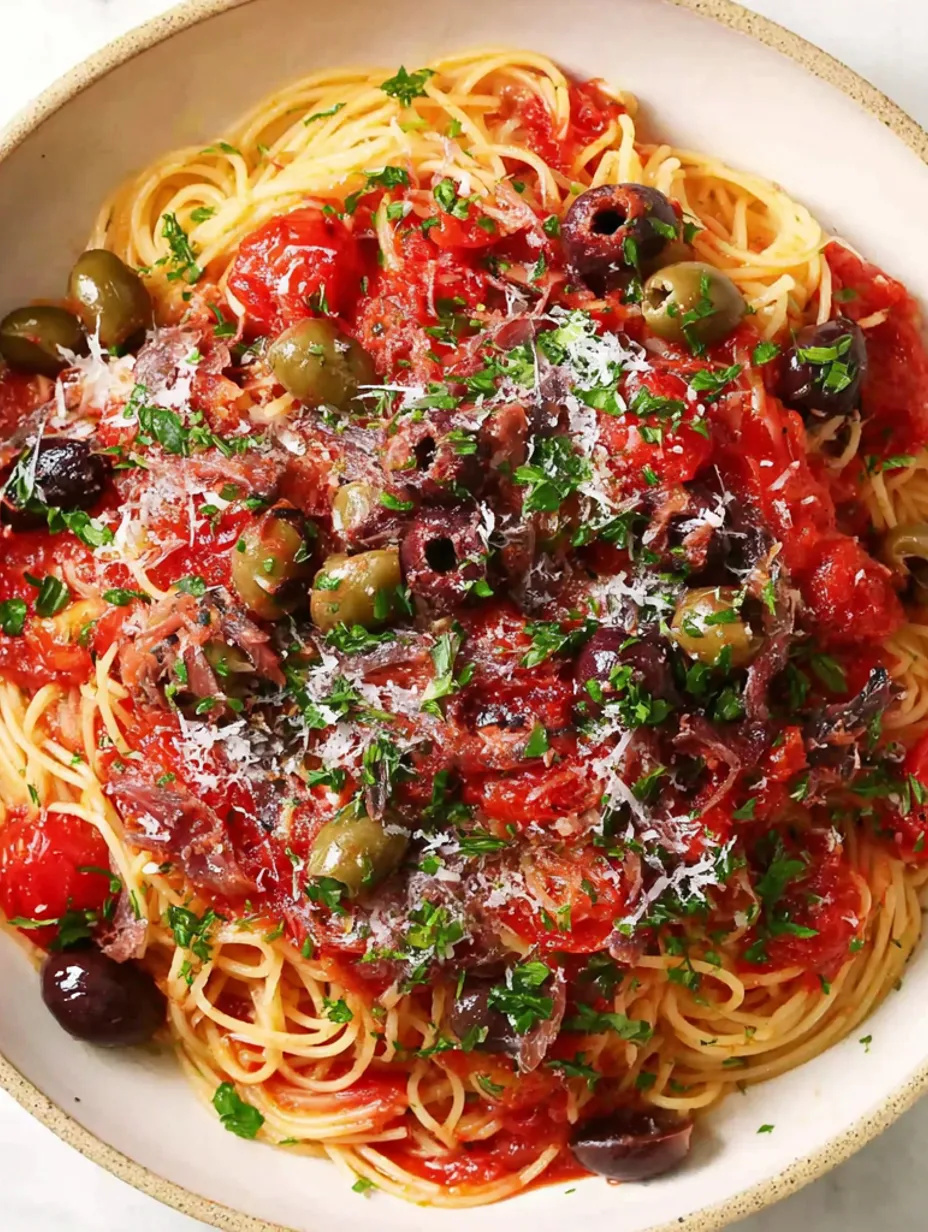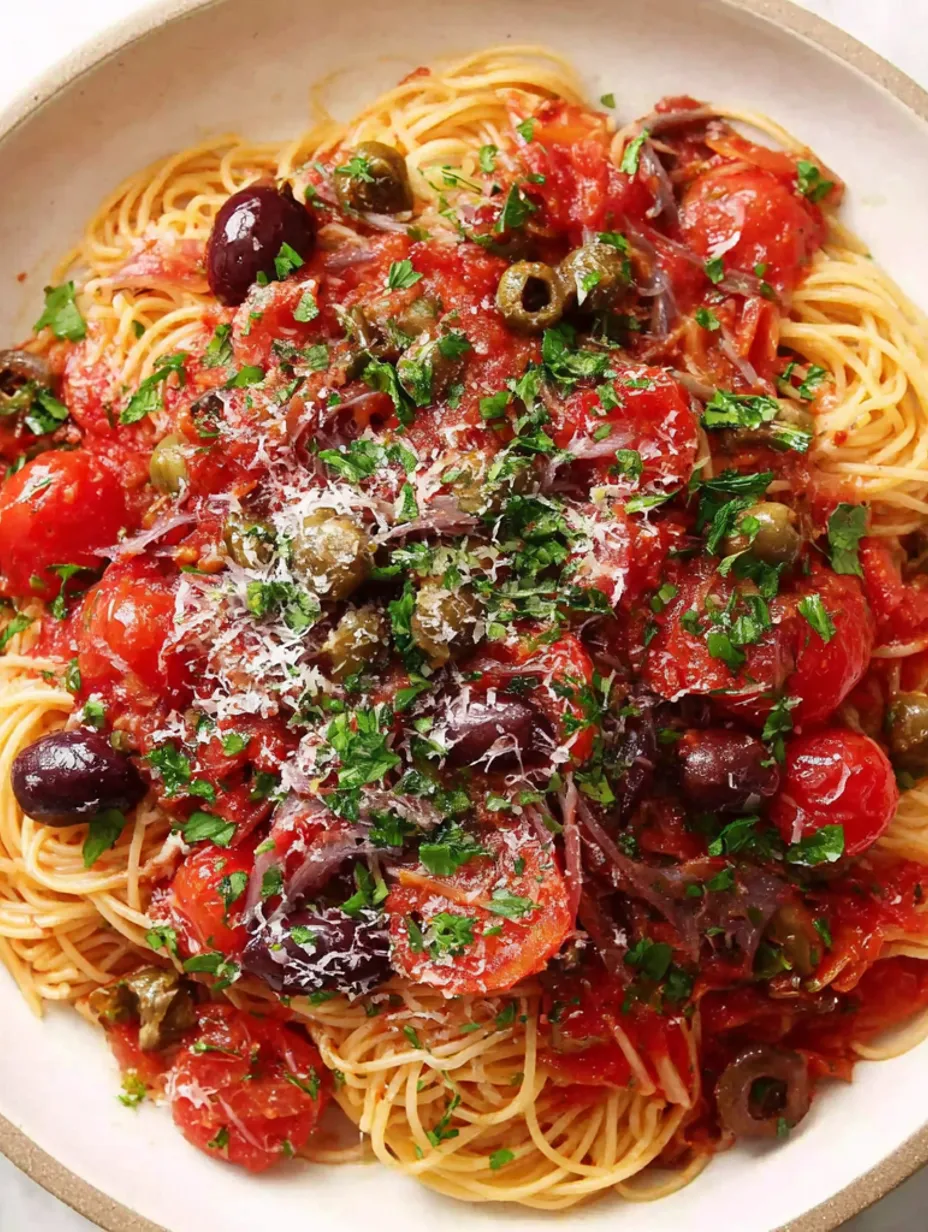 Bookmark
Bookmark
This bold and briny pasta dish has been my go-to when I need dinner on the table fast but still want something that tastes like I spent hours cooking. The combination of salty anchovies, tangy capers, and rich tomatoes creates a sauce that's both rustic and sophisticated.
I discovered puttanesca during a particularly hectic week when my pantry was nearly bare but I had all these ingredients tucked away. Now it's become my signature dish when friends drop by unexpectedly because it always impresses despite being so simple to make.
Ingredients
- Kosher salt and freshly ground black pepper: for seasoning throughout the cooking process
- 12 ounces dry angel hair pasta: which cooks quickly and holds the sauce beautifully in its thin strands
- 3 tablespoons olive oil: plus extra for tossing the pasta to prevent sticking
- One 28 ounce can whole plum tomatoes: choose San Marzano if available for the best flavor
- 6 cloves garlic: thinly sliced to release maximum flavor without overwhelming the dish
- 4 anchovy fillets: which dissolve into the sauce adding depth without fishiness
- 1/4 to 1/2 teaspoon crushed red pepper flakes: adjust to your heat preference
- 1/2 cup roughly chopped pitted black olives: Kalamata or Gaeta varieties work wonderfully
- 3 tablespoons drained jarred capers: which add bursts of tangy brightness
- 2 tablespoons chopped fresh parsley leaves: for color and freshness
- Grated Parmesan: for serving adds nutty richness to balance the bold flavors
Step by Step Instructions
- Prepare the Pasta Base:
- Bring a large pot of salted water to a rolling boil over high heat. The water should taste like mild seawater for properly seasoned pasta. Add the angel hair pasta and cook according to package directions until al dente which usually takes about 2 to 3 minutes since angel hair is so thin. Drain immediately and toss with a splash of olive oil to prevent sticking. Keep warm while you prepare the sauce.
- Prepare the Tomato Foundation:
- Drain the canned tomatoes into a large bowl making sure to reserve every drop of that precious juice. Using your hands crush the tomatoes into chunky irregular pieces. This rustic crushing technique creates the perfect texture much better than using a food processor which would make them too uniform.
- Build the Aromatic Base:
- Heat 2 tablespoons of olive oil in a large skillet over medium low heat. Add the thinly sliced garlic anchovy fillets and red pepper flakes. Cook stirring occasionally until the garlic becomes fragrant and turns a light golden color about 3 minutes. The anchovies should start to dissolve into the oil creating a savory foundation.
- Create the Sauce:
- Add the hand crushed tomatoes along with a generous pinch of both salt and pepper. Increase the heat to medium high and bring the mixture to a gentle simmer. Cook stirring occasionally until the tomatoes begin to break down and lose their raw edge about 5 to 7 minutes. The sauce should start to thicken slightly and smell incredibly aromatic.
- Add the Puttanesca Elements:
- Stir in the chopped black olives drained capers and the reserved tomato juice. The reserved juice adds crucial moisture and concentrated flavor. Continue simmering until the sauce has thickened to a consistency that will coat the pasta nicely and all the flavors have melded together about 10 minutes more.
- Combine and Finish:
- Add the warm cooked pasta directly to the skillet along with the fresh chopped parsley and the remaining tablespoon of olive oil. Using tongs or a large spoon toss everything together vigorously until the pasta is completely coated with the sauce. Taste and adjust seasoning with additional salt and pepper as needed. Serve immediately in warmed bowls with freshly grated Parmesan on the side.
 Bookmark
Bookmark
The beauty of puttanesca lies in how these humble pantry ingredients transform into something so flavorful and satisfying. I love how the anchovies completely melt away leaving behind just a subtle umami depth that makes people wonder what makes this sauce so special.
Storage Tips
Store leftover puttanesca in the refrigerator for up to three days in an airtight container. The sauce actually improves as it sits allowing all those bold flavors to meld even further. When reheating add a splash of water or olive oil to loosen the sauce and prevent the pasta from drying out.
Ingredient Substitutions
If you can't find angel hair pasta linguine or thin spaghetti work beautifully as substitutes. For those avoiding anchovies try adding an extra tablespoon of capers or a dash of Worcestershire sauce for that umami depth. Jarred marinara can replace the canned tomatoes in a pinch though you'll lose some of the rustic charm.
 Bookmark
Bookmark
Serving Suggestions
This pasta pairs wonderfully with a simple arugula salad dressed with lemon and olive oil to cut through the richness. A crusty Italian bread is perfect for soaking up any remaining sauce. For wine choose something crisp like Pinot Grigio or a light Chianti that won't compete with the bold flavors.
Cultural Context
Puttanesca originated in Naples and has become beloved worldwide for its ability to create maximum flavor from minimal ingredients. Traditional recipes vary slightly from region to region but the core elements of tomatoes olives capers and anchovies remain constant representing the essence of southern Italian cooking.
Frequently Asked Questions About Recipes
- → What type of pasta works best for puttanesca?
Angel hair pasta is ideal for puttanesca as its thin strands absorb the sauce quickly, but spaghetti or linguine can also be used.
- → Can I adjust the heat level of the sauce?
Yes, you can increase or decrease crushed red pepper flakes to suit your preferred spice level without affecting the overall flavor balance.
- → Are anchovies necessary for authentic flavor?
Anchovies provide a deep umami and saltiness that define puttanesca, but they can be substituted or omitted for dietary preferences.
- → How do I prevent the pasta from sticking after cooking?
Toss the cooked pasta with a little olive oil immediately after draining to keep strands separate and silky.
- → Can this dish be prepared ahead of time?
The sauce can be made in advance and reheated gently; freshly cooked pasta is best added just before serving to maintain texture.
